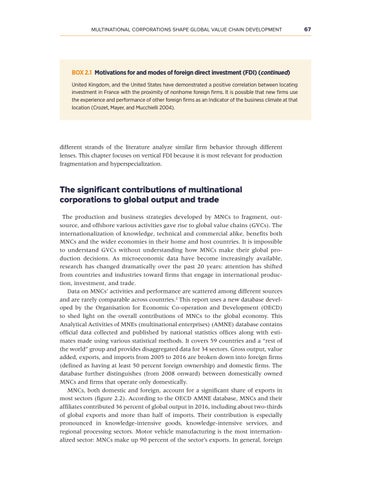Multinational Corporations Shape Global Value Chain Development
BOX 2.1 Motivations for and modes of foreign direct investment (FDI) (continued) United Kingdom, and the United States have demonstrated a positive correlation between locating investment in France with the proximity of nonhome foreign firms. It is possible that new firms use the experience and performance of other foreign firms as an Indicator of the business climate at that location (Crozet, Mayer, and Mucchielli 2004).
different strands of the literature analyze similar firm behavior through different lenses. This chapter focuses on vertical FDI because it is most relevant for production fragmentation and hyperspecialization.
The significant contributions of multinational corporations to global output and trade The production and business strategies developed by MNCs to fragment, outsource, and offshore various activities gave rise to global value chains (GVCs). The internationalization of knowledge, technical and commercial alike, benefits both MNCs and the wider economies in their home and host countries. It is impossible to understand GVCs without understanding how MNCs make their global production decisions. As microeconomic data have become increasingly available, research has changed dramatically over the past 20 years: attention has shifted from countries and industries toward firms that engage in international production, investment, and trade. Data on MNCs’ activities and performance are scattered among different sources and are rarely comparable across countries.2 This report uses a new database developed by the Organisation for Economic Co-operation and Development (OECD) to shed light on the overall contributions of MNCs to the global economy. This Analytical Activities of MNEs (multinational enterprises) (AMNE) database contains official data collected and published by national statistics offices along with estimates made using various statistical methods. It covers 59 countries and a “rest of the world” group and provides disaggregated data for 34 sectors. Gross output, value added, exports, and imports from 2005 to 2016 are broken down into foreign firms (defined as having at least 50 percent foreign ownership) and domestic firms. The database further distinguishes (from 2008 onward) between domestically owned MNCs and firms that operate only domestically. MNCs, both domestic and foreign, account for a significant share of exports in most sectors (figure 2.2). According to the OECD AMNE database, MNCs and their affiliates contributed 36 percent of global output in 2016, including about two-thirds of global exports and more than half of imports. Their contribution is e specially pronounced in knowledge-intensive goods, knowledge-intensive services, and regional processing sectors. Motor vehicle manufacturing is the most internationalized sector: MNCs make up 90 percent of the sector’s exports. In general, foreign
67










